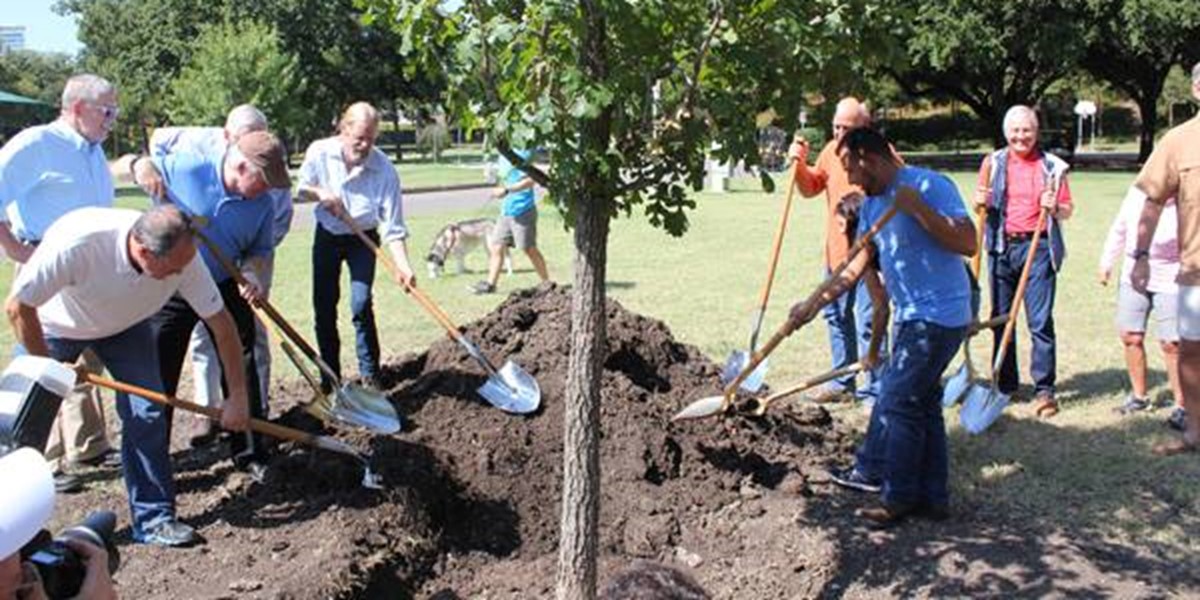

Published December 1, 1999 By ARBORILOGICAL SERVICES
One of the highlights of 1999 for Arborilogical Services, Inc. was our participation in an aggressive park clean-up project at one of Dallas’s oldest city parks, Reverchon Park. Nestled in a beautifully wooded area along the banks of Turtle Creek, Reverchon is best known for its elaborate stonework (built in the 1930’s by the W.P.A.), its mature trees, and most of all for the many special children that have visited the park since 1921. Adjacent to Texas Scottish Rite Hospital for Children, the park has been the place the children and their families could go to enjoy nature and its beauty. Unfortunately, the park has been overrun with crime and illicit activity the past twenty years, and sadly, the children stopped coming. The challenge was clear. It was time to take the park back for all the citizens of Dallas, but especially for the kids of Scottish Rite.
Steve Houser (our President) was originally contacted in January by a hospital volunteer, Quinton Johnson, and asked to help. Mr. Johnson has known us and watched us grow since our inception in 1981. His leadership and conviction toward the project stems, in part, from the tremendous care his granddaughter, Gracie Evans, now 11 years old, received as a patient when she was very young. Mr. Houser commented, “The children of Scottish Rite deserve this project. What better way can we give back to the citizens of Dallas for the many years of success that Arborilogical has enjoyed?”
What followed was nothing short of remarkable. Just a few of the participants included Park Board Members (City of Dallas), private businesses, Dallas City Council Member, John Loza, Dallas Park and Recreation employees, Police and Fire Departments, neighborhood associations, Friends of the Katy Trail, and of course Scottish Rite Hospital. Over 600 volunteers joined together to remove an estimated four hundred tons of logs, brush, trash, and debris!
One unique facet of the project was not just what was removed from the park, but what was left undisturbed. In an unprecedented effort to maintain the natural setting, leaders of the project solicited the assistance of an impressive group of environmental experts. They included; the Dallas Historic Tree Coalition, "Master Gardeners" from the Texas Agricultural Extension Service, the Master Naturalist Program, the Native Plant Society of Texas, the Dallas Trees and Parks Foundation, the Natural Area Preservation Association, the USDA Natural Resource Conservation Service, the Nature Conservancy of Texas, the Texas Society for Ecological Restoration, the Native Prairie Association of Texas, the Texas Parks and Wildlife-Urban Biologists, and the Trinity Blackland Urban Forestry Council. To our knowledge, there has never been a project that better displayed how business, community, civic and environmental groups can join together to accomplish responsible, effective, and positive change.
We are also glad to report that the Dallas Police Department has stepped up its patrol of the park on horseback, and the crime rate has dropped significantly. The Dallas Park and Recreation Department has developed an “Adopt the Park” program where local businesses and neighborhood groups have signed up to “monitor” a section of the park. The impact of the project is best described by Peggy Black, the Vice President & Director of Public Relations of Texas Scottish Rite Hospital for Children, “Since the clean-up, we have enjoyed a number of events in the park involving the children and their families. We just cannot thank everyone enough…The Park is just beautiful.”
DID YOU KNOW?
- The pine cones of the Coulter Pine (Pinus coulteri) can weigh as much as 6 lbs. when green.
- Native Americans used the wood of Slippery Elm (Ulmas rubra) for tomahawk handles.
- The root wood of Water Tupelo (Nyssa aquatic) is spongy and therefore is used locally for bottle corks.
- During revolutionary times the wood of Black Willow (Salix nigra) was used to make a high grade of charcoal for gunpowder.
- Gum can be made from mixing the sap of Sweetgum (Liquidambar styraciflua) and the fruit of Stretchberry (Forrestiera ligustrina).
